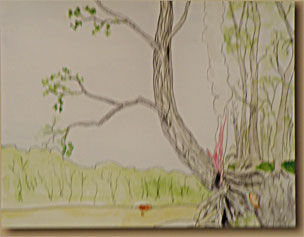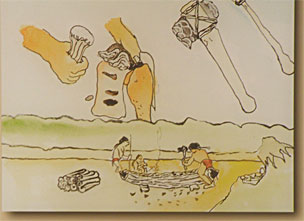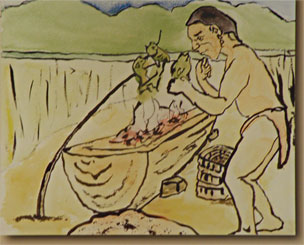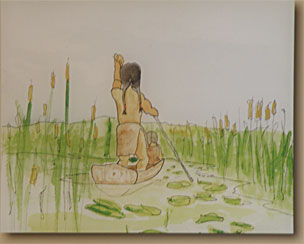|
Native American Dugout Canoes
Several kinds of canoes were made by the Plains Indians, including: the birch bark canoe; buffalo skin boats known as "bull boats"; and the dugout canoe. The dugout was used where birch bark was unavailable. The tree was selected with care, the trunk burned or cut to a length of twelve to sixteen feet, roughly shaped, then hollowed out.
The creation of canoes and other sailing crafts by hollowing out tree trunks goes back at least 10,000 years. Early indigenous peoples used controlled fires to hollow out the logs, followed by scraping with primitive stone tools such as bone knives and sharp clam-shells, giving the canoes a flat bottom with straight sides. After the Introduction of modern iron tools, the dugout became common throughout Indian country, while the forest Indian clung to the bark canoe. For at least a thousand years, the Oneoto and Dakota Indian tribes of the Minnesota River Valley, constructed dugout canoes from large basswood, cottonwood or soft maple tree trunks, for travel on the rivers and lakes in the river valley.
The sketches, above right, depict dugout canoes below Fort Snelling that were painted by Seth Eastman, career Army officer and artist appreciated for his ethnographic detail of Indian life and culture in the 1840s.
Information taken from "How to Make and Handle Indian Canoes" by Charles A. Eastman, Dakota Scholar and Writer.
Bloomington Canoe, circa 1820
During dry years of the 1960s, dugout canoes and canoe remnants were regularly discovered In the Minnesota River Valley and along the rivers and lakes in Southern Minnesota.
This Bloomington canoe from the nineteenth century was discovered on the George Hopkins river bluff property in 1967. After being authenticated by the Minnesota Historical Society, it was preserved and exhibited by the Bloomington Historical Society at the Bloomington Old Town Hall.
How Dugout Canoes Were Made
|
 |
Selecting the Log
A basswood, cottonwood or soft maple tree was selected and felled, by burning in ancient times or with iron tools, such as hatchets, in later periods.
|
|
 |
Hollowing the Log
Ancient indigenous peoples utilized primitive stone tools,
bone knives and sharp clam-shells to hollow and shape
the dugout canoe. Modem tools were used later as iron
became available, including pickaxes, chisels and knives.
Cross-wise cuts are made inside the trunk about a foot
apart, splitting the wood lengthwise until hollowed out.
|
|
 |
Burning the Log
Carefully controlled fires were used to hollow the logs. The fires were extinguished at intervals to scrape out the burned wood with a shell or stone tool. Burning seasoned the canoe.
|
|
 |
Finishing the Dugout
After the dugout canoe was left to season sufficiently long, through drying and oiling, the canoe was ready to launch. The dugout required expertise to handle inasmuch as it retained the characteristics of a log. Explorers, trappers and hunters readily adopted the convenient dugout.
|
|
|
Preserving the Artifact
The Bloomington Historical Society-owned dugout canoe antiquity was found by George Hopkins, farmer-historian of Bloomington, on his property between 1966-1968. The canoe was partially buried in mud in the Minnesota River Valley approximately one-third of the way uphill of the lower bluff. Mr. Hopkins sought the opinion of fellow historian Stanley Danielson who realized the significance of finding the rare archaeological treasure. Otto Christianson of the City of Bloomington Parks and Recreation Division was contacted and Park Maintenance staff uncovered the dugout, Approximately 16 feet in length, the find was transported to the Bloomington Old Town Hall Museum, 10200 Penn Avenue South.
An evaluation was requested from the Minnesota Historical Society conservator, who advised that the dugout be soaked in an ethylene glycol product for an indefinite period so as to permeate the dugout for preservation purposes. Glycol was the recommended conservation product at that time. The canoe was on exhibit in the lower level of the the Museum until 2007 when it was removed during the restoration of the building to its 1892 appearance. At that time, to conserve and stabilize the dugout, the Bloomington Historical Society consulted Minnesota Historical Society experts and then enlisted the expertise of Terry Brown of Museum Professionals, Inc. of Loretto, Minnesota.
The dugout was cleaned of all sand and dirt embedded deep in the recesses.
An archival-approved product (b72) was applied that permeated the decayed cells of the
dugout and provided strength to the ancient cottonwood. Then an archival artifact mount
was built for the canoe. The padded steel mount provides support for long-term exhibition.
Maritime Heritage Minnesota examined the
canoe
and estimated a build date between
1790 and 1850. During this time the canoe would have been utilized by the Dakota people,
who populated the region at that time. According to historians, dugout canoes were more
common than birch bark canoes here.
Bloomington Historical Society Archives
Exhibit and conservation by Museum Professionals, Inc.
|

